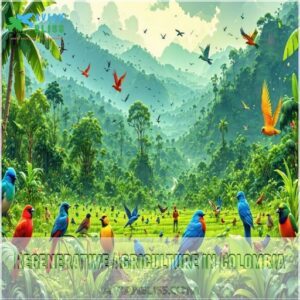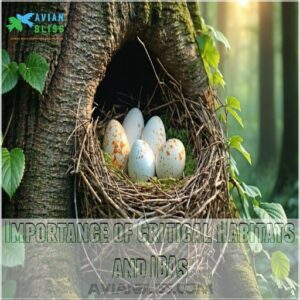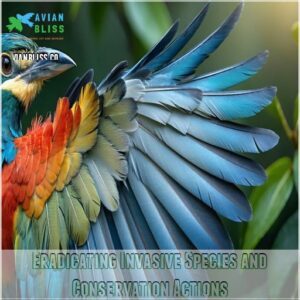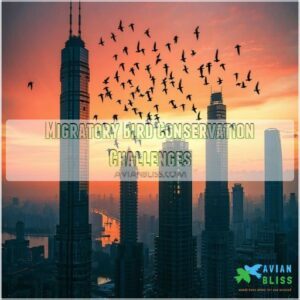This site is supported by our readers. We may earn a commission, at no cost to you, if you purchase through links.

They’re investing millions to protect our feathered friends, with Audubon Americas leading a $15 million initiative in bird-friendly agriculture.
While nearly half of bird species face decline, there’s hope on the horizon. Protected areas now safeguard 30% of Earth’s lands and seas, creating vital sanctuaries for threatened species.
Cities are embracing bird-friendly designs, transforming concrete jungles into vibrant habitats where both wildlife and communities thrive.
The future of conservation holds surprising solutions.
Table Of Contents
- Key Takeaways
- Threats to Global Bird Populations
- Conservation Strategies and Efforts
- Protecting Birds and Their Habitats
- Migratory Bird Conservation Challenges
- Effective Bird Conservation and Partnerships
- Frequently Asked Questions (FAQs)
- What is bird conservation?
- How did BirdLife stop birds from going extinct?
- What is the future of bird conservation?
- What is a strategic approach to bird conservation?
- Do migratory birds receive adequate protection?
- How can migratory birds be conserved?
- What is the best charity for bird conservation?
- What is the international organization for birds?
- Who is a famous bird conservationist?
- What is the IBA program for birds?
- Conclusion
Key Takeaways
- You are witnessing a major decline in bird populations, with nearly half of all species decreasing and one in eight facing extinction due to agriculture, logging, and climate change impacts.
- You will find agriculture is the biggest threat to birds, affecting 73% of threatened species through pesticide use, monocultures, and habitat loss, though sustainable farming practices are showing promise for recovery.
- You are seeing significant investment in conservation, with Audubon Americas leading a $15 million initiative in bird-friendly agriculture and the Conserva Aves project securing $12 million to protect 4 million acres of bird habitats.
- You can participate in the growing movement of bird-friendly cities, where urban planners are transforming concrete jungles into sanctuaries with green spaces, safe building designs, and community-led conservation efforts.
Threats to Global Bird Populations
You’ll be shocked to learn that nearly half of the world’s bird species are declining, with one in eight now facing extinction due to threats like agriculture, logging, and climate change.
North America alone has lost 3 billion birds since 1970,
while the European Union has seen 600 million birds vanish from its skies since 1980.
Agriculture’s Impact on Birds
The stark reality of modern farming practices hits birds harder than you might think. Agriculture impacts 73% of threatened bird species worldwide, creating a perfect storm of challenges for our feathered friends.
Here’s what’s driving this crisis:
- Intensive pesticide use wipes out essential insect food sources
- Large-scale monocultures eliminate natural habitat diversity
- Bird-friendly farming practices get sidelined for productivity
- Chemical runoff disrupts entire ecosystems
Sustainable practices and farm biodiversity offer hope, though. By embracing bird-friendly farming methods, we’re seeing promising signs of species recovery in agricultural landscapes.
Unsustainable Logging and Deforestation
While agriculture takes its toll on bird populations, unsustainable logging practices strike even deeper at their survival. Nearly half of threatened bird species face habitat loss from illegal logging and forest degradation.
Here’s how forest destruction impacts different bird communities:
| Region | Species Affected | Habitat Loss Rate |
|---|---|---|
| Amazon | 76 species | 17% annually |
| Congo Basin | 54 species | 13% annually |
| Southeast Asia | 89 species | 23% annually |
Habitat fragmentation from deforestation doesn’t just remove nesting sites—it breaks up essential corridors birds need for migration and feeding.
Climate Change and Birds
Beyond logging’s devastating impact, climate change poses an unprecedented threat to bird migration patterns worldwide.
Scientists have discovered that 34% of threatened bird species face dire consequences from shifting weather patterns and rising temperatures.
You’ll find bird populations struggling to adapt their migration timing, while others face potential extinction as their habitats transform.
These climate impacts force rapid avian adaptations, creating unprecedented conservation challenges for our feathered friends’ survival.
Invasive Species and Habitat Loss
In today’s rapidly changing world, invasive species impact bird populations with devastating consequences, while habitat loss pushes many species toward extinction.
You’ve probably noticed fewer songbirds in your backyard – that’s not just your imagination.
Across the globe, economic impacts of these threats are staggering, affecting:
- Native bird populations through competition for resources and nesting sites
- Critical wetlands and forests that serve as essential breeding grounds
- Local ecosystems where invasive predators decimate bird colonies
Let’s explore how habitat preservation efforts and species-specific conservation funding are turning the tide.
Conservation Strategies and Efforts
You’ll be amazed to discover how innovative market-based conservation strategies are transforming bird protection across the Americas, with groundbreaking projects in Colombia, Panama, and beyond.
From Audubon Americas’ $15 million investment in bird-friendly agriculture to the protection of critical coastal habitats, these conservation efforts are creating a blueprint for success.
These conservation efforts are creating a blueprint for success that you can support right now.
Audubon Americas’ Market-Based Approach
Audubon Americas has revolutionized bird conservation with their smart, market-based solutions that pack a real punch, addressing critical issues such as threats to bird populations today.
Their five-year plan targets six key countries with funding sources from heavy hitters like the Bezos Earth Fund.
You’ll find their success metrics speak volumes – they’re not just saving birds, they’re reshaping entire markets.
By bringing stakeholders together and focusing on long-term sustainability, they’re proving that nature and business can thrive together.
Regenerative Agriculture in Colombia
Colombia’s ambitious $15 million regenerative agriculture initiative puts farmers at the heart of bird conservation. Working with local farmers, this 10-year project transforms traditional farming into bird-friendly crops while boosting soil health and economic impact.
- Farmers learn sustainable agriculture techniques that protect native bird habitats while increasing their yields
- Water management practices create year-round bird sanctuaries in agricultural landscapes
- Conservation programs offer financial incentives for implementing bird-friendly farming methods
Coastal Resilience in Panama
While Colombian farms embrace bird-friendly practices,
Panama’s coastal regions are writing their own conservation success story.
The three-million-dollar Panama Bay project, backed by heavy hitters like the Inter-American Development Bank, is transforming wetlands and mangroves into resilient ecosystems, with supporters even able to shop for Panama Bay merchandise.
Local communities are rolling up their sleeves to restore these essential areas, creating safe havens for migratory birds while buffering against climate change’s rising threats.
Protected Area Management and Bird Conservation
The Conserva Aves initiative is reshaping protected area funding with a bold $12 million investment from the Bezos Earth Fund.
This ambitious project is establishing 30-40 new protected areas across the Tropical Andes by 2027, covering nearly 4 million acres of essential bird habitats.
Through effective monitoring and community involvement, these wildlife refuges aren’t just sanctuaries—they’re living proof that habitat restoration can turn the tide on bird habitat loss. Conserva Aves is a bold investment in conservation.
Protecting Birds and Their Habitats
You’ll discover how dedicated conservationists have protected important bird habitats worldwide, resulting in the preservation of over 726 threatened species since 2013.
When you learn about the successful efforts to restore wetlands and forests, you’ll understand why protecting these essential sanctuaries isn’t just about saving birds—it’s about preserving the natural balance that benefits all living things.
Importance of Critical Habitats and IBAs
Identifying and protecting Important Bird Areas (IBAs) stands as a game-changer in bird conservation.
These Key Biodiversity Areas serve as lifelines for countless species facing habitat loss.
Efforts to protect IBAs are further supported by initiatives offering IBA conservation tools and resources, such as those found through IBA conservation products.
Recent IBA restoration efforts have transformed threatened landscapes into thriving bird sanctuaries.
You’ll find success stories worldwide, from restored wetlands teeming with waterfowl to revitalized forests where endangered species now flourish, proving that targeted conservation works when we act together.
Designating Protected Areas for Birds
Protected areas form the backbone of bird conservation, with ambitious goals to safeguard 30% of Earth’s lands and seas.
You’ll find these sanctuaries aren’t just random patches – they’re carefully chosen key biodiversity areas that create important habitat connectivity for our feathered friends.
Through smart funding strategies and community involvement, these protected spaces work within legal frameworks to guarantee birds have room to thrive, breed, and maintain healthy populations. Protected areas are key biodiversity areas that help bird conservation.
Eradicating Invasive Species and Conservation Actions
Since 2013, invasive species control has emerged as a game-changer in bird protection programs worldwide.
Through coordinated habitat restoration efforts and species-specific actions, conservation groups have saved 21-32 bird species from extinction.
Community involvement plays a vital role, with successful invasive species eradication programs receiving conservation funding from various sources.
Bird conservation strategies now prioritize removing harmful invasive species while promoting native habitat recovery.
Migratory Bird Conservation Challenges
You’ll face the stark reality that migratory birds confront deadly challenges from urban development and fatal building collisions during their incredible journeys across continents.
While you’re enjoying city life, these remarkable creatures need your help as they navigate through an increasingly hostile landscape of glass buildings, altered habitats, and mounting environmental pressures.
Habitat Loss and Urban Development
Urban sprawl takes a heavy toll on migratory birds, transforming their natural habitats into concrete jungles.
You’ll see the impact in declining bird populations worldwide as cities expand relentlessly.
But there’s hope – many cities are now embracing sustainable development by preserving green spaces and incorporating bird-friendly design principles.
Through citizen science initiatives, you’re helping track these changes and guide species preservation efforts in urban areas.
Fatal Collisions and Threats to Migratory Birds
Every year, countless migratory birds face deadly obstacles during their journeys. Building collisions and window strikes claim millions of lives, while light pollution disrupts their navigation systems. To combat these issues, many are turning to bird collision deterrent solutions to make urban environments safer for birds.
Here’s what’s putting our feathered friends at risk:
- Urban hazards like reflective glass buildings create deadly optical illusions
- Habitat fragmentation forces birds to navigate through dangerous urban corridors
- Growing pollution affects birds’ ability to find food and shelter, accelerating species decline
Promoting Bird-Friendly Cities and Communities
Building bird-friendly cities isn’t just about preventing collisions – it’s about creating thriving urban bird habitats where both wildlife and people flourish.
You’ll find forward-thinking communities implementing nature-based solutions like green spaces, bird-safe buildings, and conservation planning initiatives.
Through citizen science and community action, cities worldwide are transforming concrete jungles into sanctuaries where diverse bird species can nest, feed, and migrate safely.
Effective Bird Conservation and Partnerships
You’ll find it remarkable how major conservation groups like CMS, AEWA, and EFTA have joined forces to protect our feathered friends across 133 countries.
Together with local communities and governments, they’ve created a powerful network.
This powerful network has saved 21-32 bird species from extinction since 1993, showing what we can achieve when we work as one to protect nature.
The Role of World Migratory Bird Day
World Migratory Bird Day stands as a beacon of hope for avian conservation, bringing together communities twice yearly to celebrate our feathered friends.
WMBDs impact reaches far beyond a single day – it’s sparked countless local initiatives and inspired global change.
Through engaging WMBD events, from citizen science projects to educational workshops, you’ll discover how shorebird migration patterns shape our world.
The migratory bird initiative has transformed public awareness, while WMBDs message continues inspiring the next generation of conservationists.
These celebrations aren’t just about bird species – they’re about building a future where humans and wildlife thrive together.
Partner Organizations and Their Efforts
Through collaborative projects, major conservation organizations have joined forces to create lasting change for bird populations worldwide.
By leveraging the power of bird conservation through citizen sciencebird conservation efforts, BirdLife International partners with Audubon and the American Bird Conservancy to maximize their conservation impact.
The Convention on Migratory Species unites 133 nations under a single conservation umbrella.
AEWA protects 255 bird species across 84 countries and the EU.
Environment for the Americas connects communities through research and outreach programs.
The East Asian-Australasian Flyway Partnership coordinates conservation across 22 countries.
Frequently Asked Questions (FAQs)
What is bird conservation?
Birds of a feather flock together when you’re involved in bird conservation.
It’s your chance to protect and restore wild bird populations.
Their habitats and ecosystems are also important, requiring strategic planning, research, and hands-on action.
How did BirdLife stop birds from going extinct?
BirdLife’s conservation efforts saved 21-32 bird species from extinction since You’ll find their work focused on protecting critical habitats, removing invasive species, and implementing targeted conservation plans for threatened birds.
What is the future of bird conservation?
You’ll see more focus on sustainable cities, regenerative agriculture, and protected areas worldwide.
Conservation efforts will target climate change impacts.
while working to restore declining populations and preserve critical habitats for generations ahead.
What is a strategic approach to bird conservation?
Strategic conservation starts with protecting critical habitats and migration routes.
You’ll want to focus on sustainable agriculture, coastal resilience, and community engagement.
While partnering with local organizations to maximize your conservation impact.
Do migratory birds receive adequate protection?
Precious protections prove partial for migratory birds worldwide.
International treaties and partnerships exist.
Enforcement gaps and habitat loss continue to challenge these remarkable travelers across their sprawling flyways.
How can migratory birds be conserved?
Protect migratory birds by creating bird-friendly cities with safe building designs.
Preserving essential habitats is also crucial.
Supporting global conservation initiatives will make a difference.
You’ll make a difference through sustainable urban planning and habitat restoration efforts.
What is the best charity for bird conservation?
While local conservation groups matter, BirdLife International leads global efforts with measurable impact.
They’ve helped save 32 species from extinction and partner with organizations worldwide.
You can donate at birdlife.org/donate.
What is the international organization for birds?
BirdLife International serves as the main global organization for birds, partnering with AEWA, CMS, EFTA, and EAAFP to protect migratory species. You’ll find them coordinating conservation efforts across 133 countries worldwide.
Who is a famous bird conservationist?
Roger Tory Peterson revolutionized bird watching through his innovative field guides.
You’ll recognize his work in the Peterson Field Guide Series, which has helped millions identify and appreciate birds since the 1930s.
What is the IBA program for birds?
Important Bird Areas (IBA) identify, protect and monitor Earth’s most important places for birds and biodiversity.
You’ll find these essential sanctuaries providing safe nesting sites, food sources, and stopover points during migration.
Conclusion
Today’s worldwide bird conservation efforts showcase humanity’s capacity to protect and restore nature.
From Colombia’s bird-friendly farms to Panama’s resilient coastlines, we’re seeing real progress.
While challenges persist, innovative solutions and partnerships are changing the game.
You’re part of this success story – whether you’re supporting local conservation groups or making your backyard bird-friendly.
Together, we’re ensuring these remarkable creatures continue to inspire future generations with their songs and soaring wings.













